Accept all cookies Accept only essential cookies See our Cookie Notice

About ESA
The European Space Agency (ESA) is Europe’s gateway to space. Its mission is to shape the development of Europe’s space capability and ensure that investment in space continues to deliver benefits to the citizens of Europe and the world.
Highlights
ESA - United space in Europe
This is ESA ESA facts Member States & Cooperating States Funding Director General Top management For Member State Delegations European vision European Space Policy ESA & EU Space Councils Responsibility & Sustainability Annual Report Calendar of meetings Corporate newsEstablishments & sites
ESA Headquarters ESA ESTEC ESA ESOC ESA ESRIN ESA EAC ESA ESAC Europe's Spaceport ESA ESEC ESA ECSAT Brussels Office Washington OfficeWorking with ESA
Business with ESA ESA Commercialisation Gateway Law at ESA Careers Cyber resilience at ESA IT at ESA Newsroom Partnerships Merchandising Licence Education Open Space Innovation Platform Integrity and Reporting Administrative Tribunal Health and SafetyMore about ESA
History ESA Historical Archives Exhibitions Publications Art & Culture ESA Merchandise Kids Diversity ESA Brand Centre ESA ChampionsLatest
Space in Member States
Find out more about space activities in our 23 Member States, and understand how ESA works together with their national agencies, institutions and organisations.
Science & Exploration
Exploring our Solar System and unlocking the secrets of the Universe
Go to topicAstronauts
Missions
Juice Euclid Webb Solar Orbiter BepiColombo Gaia ExoMars Cheops Exoplanet missions More missionsActivities
International Space Station Orion service module Gateway Concordia Caves & Pangaea BenefitsLatest
Space Safety
Protecting life and infrastructure on Earth and in orbit
Go to topicAsteroids
Asteroids and Planetary Defence Asteroid danger explained Flyeye telescope: asteroid detection Hera mission: asteroid deflection Near-Earth Object Coordination CentreSpace junk
About space debris Space debris by the numbers Space Environment Report In space refuelling, refurbishing and removingSafety from space
Clean Space ecodesign Zero Debris Technologies Space for Earth Supporting Sustainable DevelopmentApplications
Using space to benefit citizens and meet future challenges on Earth
Go to topicObserving the Earth
Observing the Earth Future EO Copernicus Meteorology Space for our climate Satellite missionsCommercialisation
ESA Commercialisation Gateway Open Space Innovation Platform Business Incubation ESA Space SolutionsLatest
Enabling & Support
Making space accessible and developing the technologies for the future
Go to topicBuilding missions
Space Engineering and Technology Test centre Laboratories Concurrent Design Facility Preparing for the future Shaping the Future Discovery and Preparation Advanced Concepts TeamSpace transportation
Space Transportation Ariane Vega Space Rider Future space transportation Boost! Europe's Spaceport Launches from Europe's Spaceport from 2012Latest
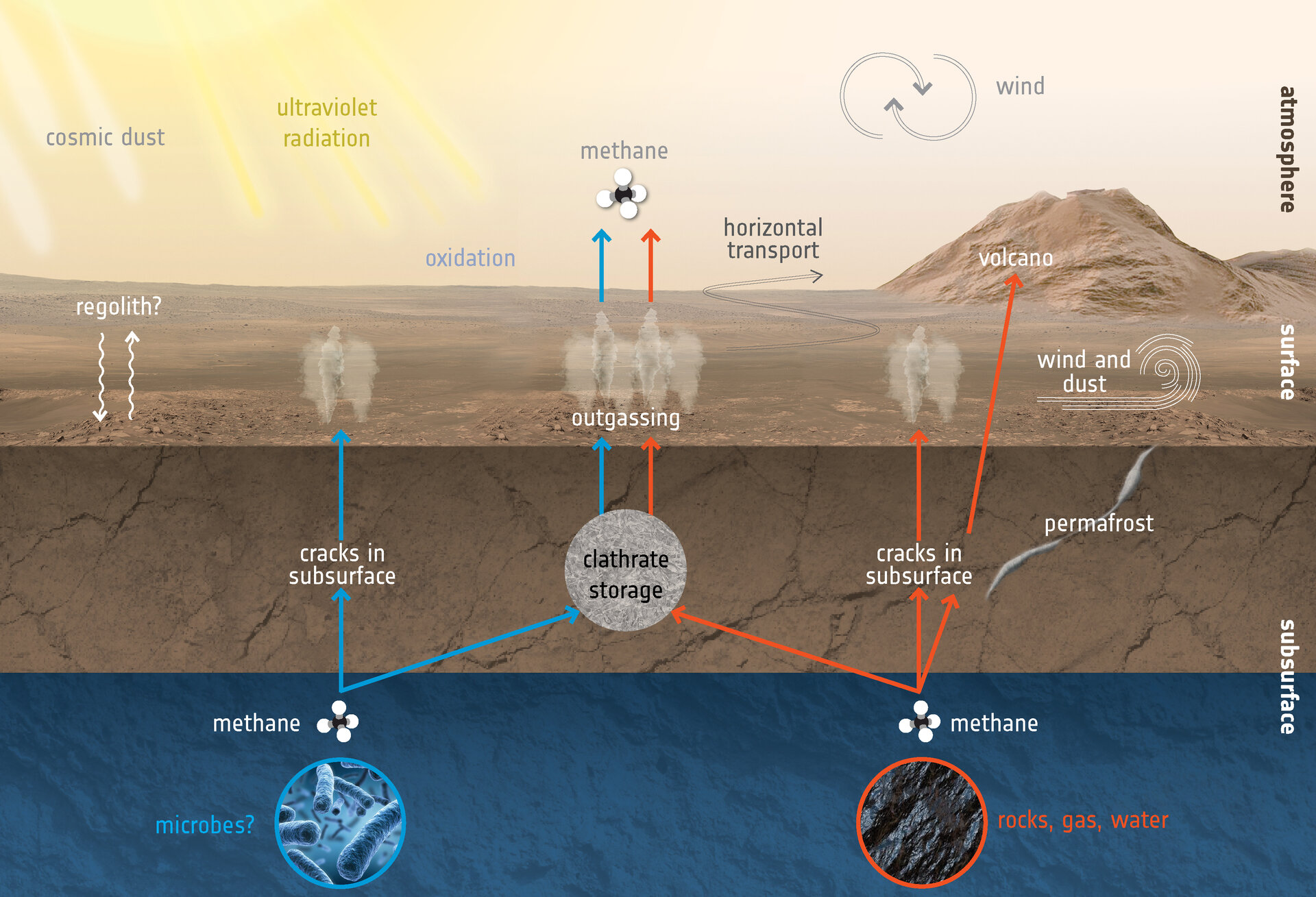
How to create and destroy methane at Mars
Thank you for liking
You have already liked this page, you can only like it once!
How methane is created and destroyed on Mars is an important question in understanding the various detections and non-detections of methane at Mars, with differences in both time and location. Although making up a very small amount of the overall atmospheric inventory, methane in particular holds key clues to the planet’s current state of activity.
This graphic depicts some of the possible ways methane might be added or removed from the atmosphere.
One exciting possibility is that methane is generated by microbes. If buried underground, this gas could be stored in lattice-structured ice formations known as clathrates, and released to the atmosphere at a much later time.
Methane can also be generated by reactions between carbon dioxide and hydrogen (which, in turn, can be produced by reaction of water and olivine-rich rocks), by deep magmatic degassing or by thermal degradation of ancient organic matter. Again, this could be stored underground and outgassed through cracks in the surface. Methane can also become trapped in pockets of shallow ice, such as seasonal permafrost.
Ultraviolet radiation can both generate methane – through reactions with other molecules or organic material already on the surface, such as comet dust falling onto Mars – and break it down. Ultraviolet reactions in the upper atmosphere (above 60 km) and oxidation reactions in the lower atmosphere (below 60 km) acts to transform methane into carbon dioxide, hydrogen and water vapour, and leads to a lifetime of the molecule of about 300 years.
Methane can also be quickly distributed around the planet by atmospheric circulation, diluting its signal and making it challenging to identify individual sources. Because of the lifetime of the molecule when considering atmospheric processes, any detections today imply it has been released relatively recently.
But other generation and destruction methods have been proposed which explain more localized detections and also allow a faster removal of methane from the atmosphere, closer to the surface of the planet. Dust is abundant in the lower atmosphere below 10 km and may play a role, along with interactions directly with the surface. For example, one idea is that methane diffuses or ‘seeps’ through the surface in localized regions, and is adsorbed back into the surface regolith. Another idea is that strong winds eroding the planet’s surface allows methane to react quickly with dust grains, removing the signature of methane. Seasonal dust storms and dust devils could also accelerate this process.
Continued exploration at Mars – from orbit and the surface alike – along with laboratory experiments and simulations, will help scientists to better understand the different processes involved in generating and destroying methane.
-
CREDIT
ESA -
LICENCE
ESA Standard Licence

How to create and destroy methane on Mars
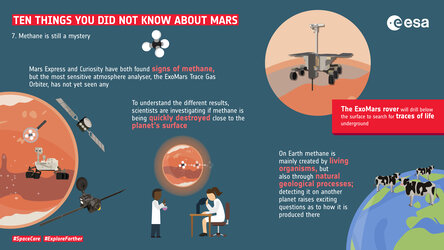
Ten things you did not know about Mars: 7. Methane
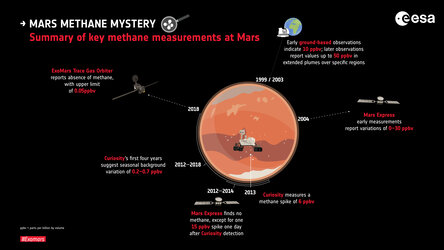
Key methane measurements at Mars
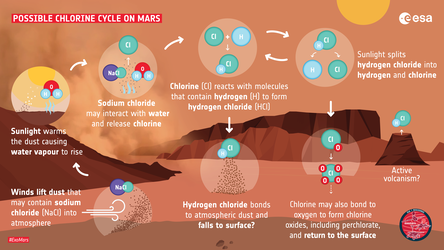
How hydrogen chloride may be created on Mars
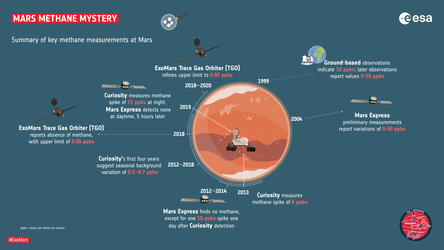














 Germany
Germany
 Austria
Austria
 Belgium
Belgium
 Denmark
Denmark
 Spain
Spain
 Estonia
Estonia
 Finland
Finland
 France
France
 Greece
Greece
 Hungary
Hungary
 Ireland
Ireland
 Italy
Italy
 Luxembourg
Luxembourg
 Norway
Norway
 The Netherlands
The Netherlands
 Poland
Poland
 Portugal
Portugal
 Czechia
Czechia
 Romania
Romania
 United Kingdom
United Kingdom
 Slovenia
Slovenia
 Sweden
Sweden
 Switzerland
Switzerland

























